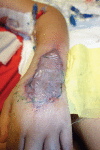A Primer on the Acute Management of Intravenous Extravasation Injuries for the Plastic Surgeon
- PMID: 29876181
- PMCID: PMC5977944
- DOI: 10.1097/GOX.0000000000001743
A Primer on the Acute Management of Intravenous Extravasation Injuries for the Plastic Surgeon
Abstract
Intravenous therapy is a common practice among many specialties. Intravenous therapy extravasation is a potential complication to such therapy. Hospitals without a dedicated wound care team trained in these interventions will often default to plastic surgical consultation, making an understanding of available interventions essential to the initial evaluation and management of these injuries. The goal of this article was to provide plastic surgeons and health care providers with a general overview of the acute management of intravenous infiltration and extravasation injuries. Though the decision for surgical versus nonsurgical management is often a clear one for plastic surgeons, local interventions, and therapies are often indicated and under-utilized in the immediate postinfiltration period. Thorough knowledge of these interventions should be a basic requirement in the armamentarium of plastic surgery consultants.
Figures





Similar articles
-
Plastic surgery telehealth consultation expedites Emergency Department treatment.J Telemed Telecare. 2017 Feb;23(2):321-327. doi: 10.1177/1357633X16639459. Epub 2016 Jul 8. J Telemed Telecare. 2017. PMID: 27056907
-
Sartorius Muscle Flaps: Perioperative Outcomes Based on Surgical Specialty.Ann Vasc Surg. 2017 Aug;43:226-231. doi: 10.1016/j.avsg.2017.01.003. Epub 2017 Mar 1. Ann Vasc Surg. 2017. PMID: 28258021
-
Facial trauma coverage among level-1 trauma centers of the United States.J Oral Maxillofac Surg. 2008 May;66(5):963-7. doi: 10.1016/j.joms.2008.01.020. J Oral Maxillofac Surg. 2008. PMID: 18423287
-
Management of extravasation injuries: a focused evaluation of noncytotoxic medications.Pharmacotherapy. 2014 Jun;34(6):617-32. doi: 10.1002/phar.1396. Epub 2014 Jan 13. Pharmacotherapy. 2014. PMID: 24420913 Review.
-
American Gastroenterological Association Clinical Practice Update: Management of Pancreatic Necrosis.Gastroenterology. 2020 Jan;158(1):67-75.e1. doi: 10.1053/j.gastro.2019.07.064. Epub 2019 Aug 31. Gastroenterology. 2020. PMID: 31479658 Review.
Cited by
-
Efficacy of Hyaluronidase in the Mannitol Extravasation Induced Compartment Syndrome-A Case Report and Review of Literature.Turk J Anaesthesiol Reanim. 2021 Aug;49(4):329-333. doi: 10.5152/TJAR.2021.570. Turk J Anaesthesiol Reanim. 2021. PMID: 35110016 Free PMC article.
-
A new approach to skin extravasation injury management during the neonatal period.BMC Pediatr. 2022 Jul 26;22(1):451. doi: 10.1186/s12887-022-03511-y. BMC Pediatr. 2022. PMID: 35883040 Free PMC article.
-
Post-operative ascites of unknown origin after laparoscopic cholecystectomy: Case report.Ann Med Surg (Lond). 2022 Mar 4;76:103431. doi: 10.1016/j.amsu.2022.103431. eCollection 2022 Apr. Ann Med Surg (Lond). 2022. PMID: 35284068 Free PMC article.
-
Phenytoin Induced Purple Glove Syndrome: An Effective Management Technique.Hosp Pharm. 2024 Jun;59(3):276-281. doi: 10.1177/00185787231224064. Epub 2024 Jan 28. Hosp Pharm. 2024. PMID: 38764997 Free PMC article.
-
Safety considerations related to intravenous contrast agents in pediatric imaging.Pediatr Radiol. 2023 Jun;53(7):1352-1363. doi: 10.1007/s00247-022-05470-z. Epub 2022 Aug 9. Pediatr Radiol. 2023. PMID: 35941280 Review.
References
-
- Feldmann H. [History of injections. Pictures from the history of otorhinolaryngology highlighted by exhibits of the German History of Medicine Museum in Ingolstadt]. Laryngorhinootologie. 2000;79:239–246.. - PubMed
-
- Coyle C, Griffie J, Czaplewski L. Eliminating extravasation events: a multidisciplinary approach. Infusion Nurses Society. 2015;38:43–50.. - PubMed
-
- Dychter S, Gold D, Carson D, et al. Intravenous therapy: a review of complications and economic considerations of peripheral access. Art Science Infusion Nursing. 2012;35:84–91.. - PubMed
-
- Scuderi N, Onesti MG. Antitumor agents: extravasation, management, and surgical treatment. Ann Plast Surg. 1994;32:39–44.. - PubMed
-
- Lake C, Beercroft CL. Extravasation injuries and accidental intra-arterial injection. Continuing education in anaesthesia. Crit Care Pain. 2012;10:109–112..
LinkOut - more resources
Full Text Sources
Other Literature Sources
